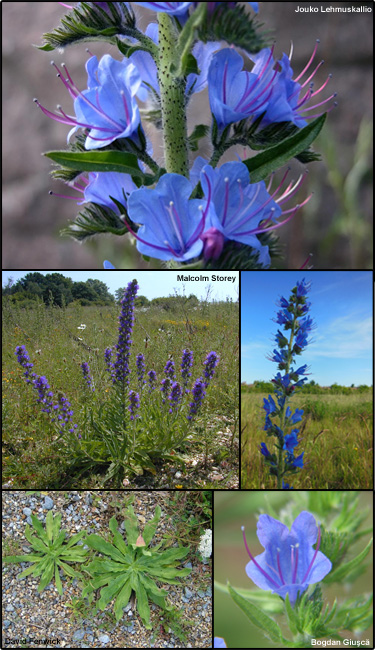Common viper's bugloss (Echium vulgare)
 Common Names: Blueweed, blue thistle, blue devil, viper's bugloss, snake flower
Common Names: Blueweed, blue thistle, blue devil, viper's bugloss, snake flowerDescription: It was introduced to the United States in the early 1800's.
Habit: Biennial or short-lived monocarpic perennial. Can grow up to 36 inches tall.
Leaves: Initially forms as a basal rosette. Rosette leaves are simple, entire, oblanceolate, approx. 2.5 to 10 in. in length and 0.5-3 in. wide with a single vein and short petiole. Stem leaves are alternate, sessile, lenear-lanceolate and become progressively smaller toward the top. Covered in stout, spreading hairs that have a swollen red, purple or black base, underlain by smaller hairs.
Stems: Mature plants grow one to many erect, branching, flowering stems reaching over 36 inches in height. Covered in stout, spreading hairs that have a swollen red, purple or black base, underlain by smaller hairs.
Flowers: Showy, range in size from 0.4 to 0.8 inch. Funnel-shaped, five-lobed flowers are typically bright blue, but may also be purple, pink or rarely, white. Another identifying characteristic is the five pink or red stamens, one of which is noticeably short than the other four, which extend beyond the corolla tube.
Fruit and seeds: Seeds are known as nutlets. They are brown or gray in color with a rounded pyramid shape, and are very small, less than 0.10 in in diameter. The surface is rough and very hard.
Habitat: Native to southern Europe. Commonly found in disturbed areas and overgrazed range or pastureland.
Reproduction: Seeds are dispersed via, wind, water, animals and humans. Wind can distribute seeds up to 16 ft.
Similar species: Can be mistaken for threadleaf phacelia (Phacelia linearis), Common bugloss(Anchusa officinalis) or Houndstongue (Cynoglossum officinale) but can be distinguised by its spotted stems.
Monitoring and rapid response: Pulling or digging by hand works well for smaller infestations if soil is moist. Care should be taken when hand pulling to ensure the tap root is removed, because this plant can regenerate if the root remains. Credits: The information provided in this factsheet was gathered from the Montana State University Extension: Biology, Ecology and Management of Blueweed.
Individual species images that appear with a number in a black box are courtesy of the Bugwood.org network (http://www.invasive.org). Individual photo author credits may not be included due to the small display size of the images and subsequent difficulty of reading the provided text. All other images appear courtesy of Google (http://images.google.com).
Common Name: | Common viper's bugloss |
Scientific Name: | Echium vulgare |
Family: | Boraginaceae (Borage) |
Duration: | Annual, Biennial, Perennial |
Habit: | Herbs |
USDA Symbol: | ECVU |
